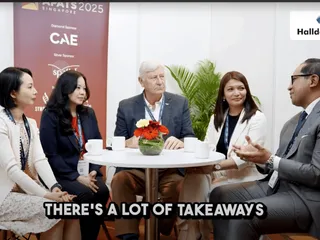Tech Deep Dive: The Increasingly Capable Flight Training Device
Contact Our Team
For more information about how Halldale can add value to your marketing and promotional campaigns or to discuss event exhibitor and sponsorship opportunities, contact our team to find out more
The Americas -
holly.foster@halldale.com
Rest of World -
jeremy@halldale.com

Buckle up. There is nothing less than a whirlwind of activities in the flight training device (FTD) market for military and commercial aviation training enterprises.
XR, AI and more robust physics-based modeling are among the technologies strengthening these trainers’ capabilities. At the same time, the use cases for FTDs and their enabling systems are expanding in the military and adjacent high-risk sectors.
This article provides market insights from two FTDs suppliers – Frasca for the training devices it delivers for military customers and entrol for the trainers it supplies to the civil aviation community. As our followers are aware, Frasca and entrol provide FTDs to both market segments.
The author also provides views from Pan Am Flight Academy – one randomly selected training organization with FTDs in its inventory.
Military FTD Trends and Developments
Randy Gawenda, Business Development Manager, at Urbana, Illinois-based Frasca, said his company is seeing an emphasis for more embedded tactical capabilities that make these devices full mission FTDs. The executive further observed there is a deepening awareness, based on recent large military GBTS (ground-based training system) programs, that the training enterprise “gets a much better bang for the buck from requirements that are for type-specific (FAA Level 7 and EASA FTD 3) FTDs. You can get a larger quantity of high-fidelity trainers instead of one or two large FFSs. This allows a more efficient training throughput without sacrificing quality.”
Gawenda provided his insights from the perspective of Frasca FTDs having been delivered to customers in more than 70 nations around the globe, including all US DoD branches.
The executive observed the US Navy TH-73A GBTS, and the UK MFTS (Military Flight Training System) and Royal Canadian Air Force’s FAcT (Future Aircrew Training) programs, all had FTDs that consisted of the bulk of the simulator deliveries. For the US Navy, Frasca has converted
three TH-57A FTDs to TH-73A FTDs and is scheduled to complete another three TH-57-to-TH-73A conversions in 2025.
And here is another trend in the military FTD sector, with these organizations increasingly buying simulation hardware and capability that is suited or matched to the level of learning need and desired outcome – beyond the intent of delivering one simulator with the highest-level regulatory agency rating achievable. “We are seeing desktop avionics trainers and part-task trainers (PTTs) become more the norm rather than the exception. These lower-level devices support the type-specific FTDs by off-loading familiarization and operational procedures that would be much more expensive if you are using an FFS or the actual aircraft. We are seeing defense customers become more deliberate in terms of how they establish their requirements and perform more
critical analysis on what is actually needed, rather than simply relying on outdated thought processes and methods.”
In terms of enabling PTTs, Frasca has delivered 12 mixed-reality (MR) training devices to the US Navy for the TH-73A program, with the last five of the 12 PTTs delivered in August 2024. Gawenda emphasized XR and its sub-applications – VR, MR, AR – provide new technology that can help enhance certain training tasks or provide lower-level trainers to enable familiarization and procedural training in small, inexpensive type of units. “While we see a lot of single-seat fixed wing trainers and fighters implement VR and MR technology because it is fairly straight-forward to do, the TH-73A MR devices we delivered had unique aspects in that they were rotary-wing devices, allowing both the pilot and copilot to use their respective head-mounted displays (HMDs) simultaneously. Further, they provide NVG emulation, and can be networked together in order to facilitate formation and collective training scenarios.”
While Frasca continues to explore and develop multiple outputs of XR technology, it is concurrently upgrading and adding features to its TruVision Global image generator – bringing additional fidelity to the FTD. “The ability to provide photo-realistic models and visuals are an area of growing demand and we are well positioned with products and features to satisfy that requirement. While computer processing gets faster, it allows higher granularity in our flight, engine, and systems models.” Good dynamic rotorcraft modeling is very intensive, Gawenda said, and noted Frasca’s designs and developments provide training capabilities that a few years back, weren’t readily available. “Aerodynamic modeling of things like loss of tail-rotor effectiveness, vortex-ring state, dynamic rollovers, settling with power and retreating blade stall provide a better learning and training environment for these areas which are too dangerous to demonstrate in the aircraft or expose the aircraft and pilots to unnecessary risk. Even training elements like wake-flow interaction between aircraft in formation, ditching, or other types of beyond the edge of the envelope can be trained in the FTD with much more realism.”
Commercial Sector FTD Snapshot
Madrid, Spain-based entrol is advancing FTDs for fixed-wing and rotary aircraft across the civil aviation enterprise as well as companion flight navigation procedures trainers (FNPTs) – reconfigurable en-1000x, en-4000x and King Air Simulators, and devices for the A320 family. The OEM is a recognized player in the global market with, in one case, its en-1000x devices being in service in 11 nations.
Iñigo Hernandez, Business Manager at entrol, noted one important trend, with the OEM receiving more requests to support mission/operator training – in one instance, for firefighting. “Unfortunately, fire-fighting simulators are in more demand every day because of climate change
as we saw with the large-scale fires in 2024 in California and elsewhere around the world. In 2024 we updated our firefighting mission simulator [Air Tractor (AT802)] and we have received great feedback from our customers. We expect to install an AT 802 simulator this year, specifically focused on firefighting. We will also improve our firefighting module with the extra feedback we get from our customers.” Entrol’s firefighting module can be used with any of the OEM’s simulators. “Entrol has, for instance, several H145s or S-64s equipped with this module,” Hernandez added.
Entrol’s business model includes its preference to keep most of its technology in-house to permit the OEM to be flexible and optimize its maintenance service. The executive added, “Using the same technology between all of our simulators allows us to improve our product globally and reutilize the upgrades we make to our products.” Yet, entrol is not “going it alone” and has key industry partners including: E2M for control loading systems; Unreal Engine to power Envision, (entrol’s IG); and Varjo for MR headsets.
FTD Developments on our Watch List
Frasca’s Gawenda noted his TH-73A MR devices will soon feature some incredibly innovative software and technology that leverage AI and help provide an even more immersive environment as well as enable gamified lessons and maneuvers. The technology investments are intended to allow self-paced learning to become more productive with a high level of positive transfer of training enabled as a result.
In one instance, “The TH-73A devices will integrate ASTi’s SERA (Simulated Environment for Realistic ATC) product which helps create a virtualized ATC environment so that realistic communications are produced in the simulator,” Gawenda noted and added another concurrent effort integrates TakeFlight Interactive’s AIVIator product. The executive explained, in part, this is a virtualized AI instructor that provides several different levels of capability.
Back at entrol, the company reported it has received a requirement for its Piaggio Avanti FTD for an undisclosed customer. Hernandez noted the prospective customer purchased the Level 2 FTD which will be installed in the upcoming months. More details on the acquisition will be revealed after the installation has been completed.
As this article was being prepared for posting entrol launched its Enwall high-resolution LED panel system that was designed to provide an immersive, distortion-free visual experience, eliminating the need for projectors and offering a wider field-of-view (FOV) for enhanced situational awareness. A company statement noted that with a fully modular and scalable structure, Enwall integrates both an LED wall and a reinforced LED floor, creating a versatile and realistic training environment for helicopter and fixed-wing aircraft simulation. Other attributes of the new product were reported to include: better resolution; better color contrast; and easier maintenance, among others. Hernandez added, “if we compare the LED with the XR, we can: eliminate the head-mounted device; improve the peripheral view; remove simulator sickness; increase training session duration; and train to multi-crew operations. Another advantage of this solution is that as it is modular, you can customize the FOV to your needs and extend it as required.”
Elsewhere in 2025, entrol’s 20th anniversary year, the company will also:
- interestingly advance its FFS Level B projects;
- complete more than 15 different factory acceptance tests;
- attend trade shows around the globe and will be featuring a simulator to support up to 200 different “testers” at each event;
- consolidate its Monterrey, Mexico maintenance center to better support its FTDs and other products; and
- respond to projected growth in the mission-focused operator market (for search-and rescue, firefighting, helicopter emergency medical service and others.)
An Operator Perspective
And what about the customer and operators of FTDs entering defense and military training organizations?
Ed Wegel, CEO Pan Am Flight Academy, said that in recent years, his organization has acquired multiple FTDs. “When we acquired our B757 Level D simulator from American Airlines, we also acquired the corresponding Level 5 FTD. Additionally, we operate a Level 4 Boeing B767-300 flat panel trainer and four B737NG flat panel trainers, which are equipped with tactile hardware, including throttle quadrants, FMS boxes, and flight guidance panels. These were also acquired from another major US carrier.”
Asked about the business case to invest in FTDs when compared to FFSs, the corporate leader initially responded the business cases can vary, but added, Pan Am’s primary consideration is customer demand—if there is a need for FTDs or other lower-level devices, this training organization evaluates whether it can provide them. “Each customer that utilizes our FTDs has its own approved training programs, which ultimately determine the extent to which they can incorporate FTDs into their training curriculum. Some operators prefer using FTDs instead of a FFS, as they provide many of the same training capabilities at a significantly lower cost. At Pan Am, our FTDs are primarily used during initial training and are often utilized for remedial training when necessary.”
With a focus on 2025, Pan Am has an upgrade program that looks at the requirements from the equipment manufacturers, the regulatory agencies as well as its customers. “Currently, we do not have any orders for new FTDs in 2025; however, we are always looking for training equipment that could benefit our customers,” the CEO said and provided one vital perspective on the future of this industry segment. “We believe FTDs will continue to evolve much like the other training equipment. Some of the new technologies are incredible and are very promising. We are keeping a close eye on the progress of the some of the newer technologies but for now we are continuing to stay focused on the needs of our customers with some of the more traditional FTDs and Full Flights.”
Of importance, this 26 February Acorn Capital Management acquired Pan Am Flight Academy.
.png/r%5Bwidth%5D=320/7f2021f0-9a0d-11f0-b8f7-272ce5993c28-nano-banana-2025-09-24T11-07-03%20(1).webp)

